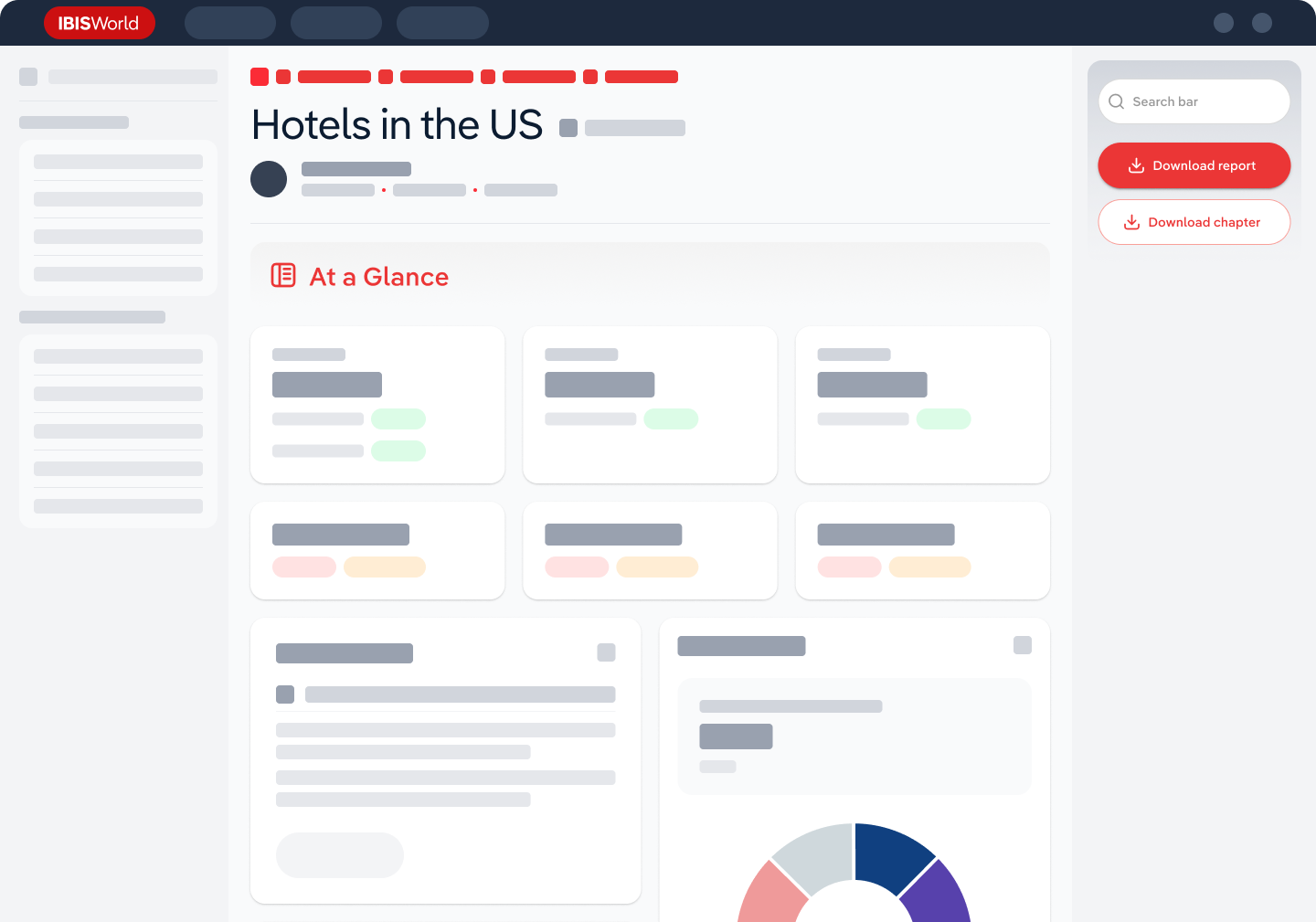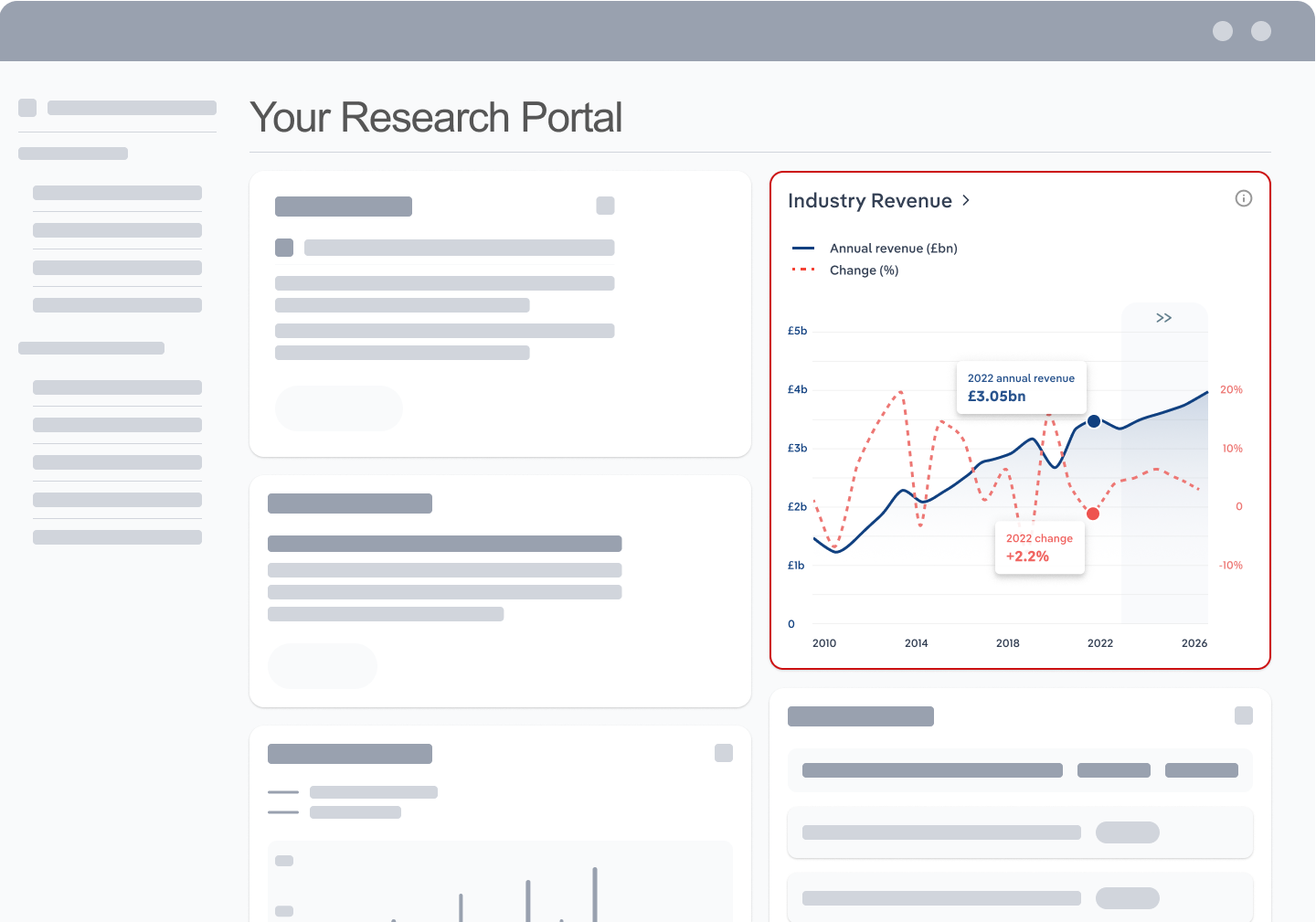Industry Statistics and Trends
Market size and recent performance (2015-2030)
Industry revenue has declined at a CAGR of 0.3 % over the past five years, to reach an estimated €9.7bn in 2025.
Trends and Insights
Increasing digitalisation is a growth driver for the marketing industry
- The digitalisation index shows that the level of digitalisation in Germany has risen continuously in recent years. In 2024, the value rose from 108.1 to 113.6 percentage points compared to the previous year. Germany has therefore become 14% more digital overall since 2020. The increasing use of mobile devices and the popularity of streaming services and social media are driving the growth of digital advertising.
- Additional trends and insights available with purchase
Industry outlook (2025-2030)
Market size is projected to grow over the next five years.
Trends and Insights
The development of new products in the field of digital media will continue
- The development of new product offerings in the digital sector will continue in the coming years as the online activities of the advertising-relevant audience increase. Internet-based applications are likely to move further into the centre of leisure entertainment. According to the digitalisation index, the level of digitalisation in the German economy is steadily increasing. The digitalisation index stood at 113.6 percentage points in 2024, compared to 108.1 percentage points in 2023.
Biggest companies in the Media Representation in Germany
| Company | Market Share (%)
2025 | Revenue (€m)
2025 |
|---|---|---|
Ströer SE & Co. KGaA | 1,976.7 | |
Bertelsmann SE & Co. KGaA | 1,538.7 | |
Google Germany GmbH | 1,425.2 |
To view the market share and analysis for all 5 top companies in this industry, view purchase options.
Products & Services Segmentation
Industry revenue is measured across several distinct product and services lines, including Marketing and procurement of advertising space, Marketing and procurement of advertising time and Marketing and brokering of hybrid offers. Marketing and procurement of advertising space is the largest segment of the Media Representation in Germany.
Trends and Insights
The marketing and brokerage of advertising space is likely to become less important in the coming years
- The traditional marketing and placement of advertising space includes the placement of advertising space of all kinds, for example outdoors on billboards and vehicles, but also in newspapers, magazines and online. Industry activities also include the management of advertising space, for example by hanging up posters in public spaces.
- More insights available in the full report
Table of Contents
About this industry
Industry definition
The industry of marketing and brokering advertising time and advertising space deals with the sale and resale of broadcasting time and advertising space for advertising purposes on television, radio, the internet and in public spaces.
What's included in this industry?
Products and services covered in the Media Representation industry in Germany include Marketing and procurement of advertising space, Marketing and procurement of advertising time and Marketing and brokering of hybrid offers.Companies
Companies covered in the Media Representation industry in Germany include Ströer SE & Co. KGaA, Bertelsmann SE & Co. KGaA and Google Germany GmbH.Purchase this report to view all 5 major companies in this industry.
Related Terms
Related terms covered in the Media Representation industry in Germany include banner advertising, layer ads, programmatic advertising, addressable tv and smart tv.Industry Code
WZ 73.12 - Media Representation in Germany
Performance
Get an indication of the industry's health through historical, current and forward-looking trends in the performance indicators that make or break businesses.
Analyst insights
In the last five years, the industry has been able to win many private and public owners of advertising space as customers who had previously marketed their advertising space ...
In this chapter (4)
- Current Performance
- Outlook
- Volatility
- Life Cycle
Key metrics
- Annual Revenue, Recent Growth, Forecast, Revenue Volatility
- Number of Employees, Recent Growth, Forecast, Employees per Business, Revenue per Employee
- Number of Businesses, Recent Growth, Forecast, Employees per Business, Revenue per Business
- Total Profit, Profit Margin, Profit per Business
Charts
- Revenue, including historical (2015-2024) and forecast (2025-2030)
- Employees, including historical (2015-2024) and forecast (2025-2030)
- Businesses, including historical (2015-2024) and forecast (2025-2030)
- Profit, including historical (2015-2025)
- Industry Volatility vs. Revenue Growth
- Industry Life Cycle
Detailed analysis
- Trends in supply, demand and current events that are driving current industry performance
- Expected trends, economic factors and ongoing events that drive the industry's outlook
- Key success factors for businesses to overcome volatility
- How contribution to GDP, industry saturation, innovation, consolidation, and technology and systems influence the industry's life cycle phase.
Products and Markets
Learn about an industry's products and services, markets and trends in international trade.
Analyst insight
Addressable TV combines linear television with digital advertising and enables personalised advertising on television. Offers of this kind offer great potential to further in...
In this chapter
- Products & Services
- Major Markets
Key metrics
- Largest market segment and value in 2025
- Product innovation level
Charts
- Products & services segmentation in 2025
- Major market segmentation in 2025
Detailed analysis
- Trends impacting the recent performance of the industry's various segments
- Innovations in the industry's product or service offering, specialization or delivery method
- Key factors that successful businesses consider in their offerings
- Buying segments and key trends influencing demand for industry products and services
Geographic Breakdown
Discover where business activity is most concentrated in an industry and the factors driving these trends to find opportunities and conduct regional benchmarking.
Analyst insights
The centre region is attractive due to its proximity to the media city of Cologne and many industrial groups. For this reason, most industry players have settled here.
In this chapter (1)
- Business Locations
Charts
- Share of revenue, establishment, wages and employment in each region
- Share of population compared to establishments in each region in 2025
Tables
- Number and share of establishments in each region in 2025
- Number and share of revenue each region accounts for in 2025
- Number and share of wages each region accounts for in 2025
- Number and share of employees in each region in 2025
Detailed analysis
- Geographic spread of the industry across Europe, and trends associated with changes in the business landscape
- Key success factors for businesses to use location to their advantage
Competitive Forces
Get data and insights on what's driving competition in an industry and the challenges industry operators and new entrants may face, with analysis built around Porter's Five Forces framework.
Analyst insights
Internal competition is likely to decrease overall in the next five years. The reason for this is the increasing consolidation of the market, especially the market for outdoo...
In this chapter (4)
- Concentration
- Barriers to Entry
- Substitutes
- Buyer & Supplier Analysis
Key metrics
- Industry concentration level
- Industry competition level and trend
- Barriers to entry level and trend
- Substitutes level and trend
- Buyer power level and trend
- Supplier power level and trend
Charts
- Market share concentration among the top 4 suppliers from 2020-2025
- Supply chain including upstream supplying industries and downstream buying industries, flow chart
Detailed analysis
- Factors impacting the industry’s level of concentration, such as business distribution, new entrants, or merger and acquisition activity.
- Key success factors for businesses to manage the competitive environment of the industry.
- Challenges that potential industry entrants face such as legal, start-up costs, differentiation, labor/capital intensity and capital expenses.
- Key success factors for potential entrants to overcome barriers to entry.
- Competitive threats from potential substitutes for the industry’s own products and services.
- Key success factors for how successful businesses can compete with substitutes.
- Advantages that buyers have to keep favorable purchasing conditions.
- Advantages that suppliers have to maintain favorable selling conditions.
- Key success factors for how businesses can navigate buyer and supplier power.
Companies
Learn about the performance of the top companies in the industry.
Analyst insights
Modern technologies such as Addressable TV make it possible to broadcast TV adverts in real time on internet-enabled devices. ProSiebenSat.1 was the first TV group in Germany...
In this chapter
- Market Share Concentration
- Companies
- Company Spotlights
Charts
- Industry market share by company in 2021 through 2025
- Major companies in the industry, including market share, revenue, profit and profit margin in 2025
- Overview of Ströer SE & Co. KGaA's performance by revenue, market share and profit margin from 2019 through 2025
- Overview of Bertelsmann SE & Co. KGaA's performance by revenue, market share and profit margin from 2019 through 2025
- Overview of Google Germany GmbH's performance by revenue, market share and profit margin from 2019 through 2025
- Overview of revenue, market share and profit margin trend for 2 additional companies
Detailed analysis
- Description and key data for Ströer SE & Co. KGaA, and factors influencing its performance in the industry
- Description and key data for Bertelsmann SE & Co. KGaA, and factors influencing its performance in the industry
- Description and key data for Google Germany GmbH, and factors influencing its performance in the industry
- Description, key data and performance trends for 2 additional companies
External Environment
Understand the demographic, economic and regulatory factors that shape how businesses in an industry perform.
Analyst insights
The increasing level of digitalisation is having a positive impact on industry revenues. The increased use of digital media means that better prices and higher revenues can b...
In this chapter
- External Drivers
- Regulation & Policy
- Assistance
Key metrics
- Regulation & policy level and trend
- Assistance level and trend
Charts
- Regulation & Policy historical data and forecast (2015-2030)
- Assistance historical data and forecast (2015-2030)
Detailed analysis
- Demographic and macroeconomic factors influencing the industry, including Regulation & Policy and Assistance
- Major types of regulations, regulatory bodies, industry standards or specific regulations impacting requirements for industry operators
- Key governmental and non-governmental groups or policies that may provide some relief for industry operators.
Financial Benchmarks
View average costs for industry operators and compare financial data against an industry's financial benchmarks over time.
Analyst insights
The profit margin is expected to remain stable over the next five years. Large marketing groups will be able to achieve higher profit margins, while the smaller players will ...
In this chapter
- Cost Structure
- Financial Ratios
- Key Ratios
Key metrics
- Profit margin, and how it compares to the sector-wide margin
- Average wages, and how it compares to the sector-wide average wage
- Largest cost component as a percentage of revenue
- Industry average ratios for days' receivables, industry coverage and debt-to-net-worth ratio
Charts
- Average industry operating costs as a share of revenue, including purchases, wages, depreciation, utilities, rent, other costs and profit in 2025
- Average sector operating costs as a share of revenue, including purchases, wages, depreciation, utilities, rent, other costs and profit in 2025
- Investment vs. share of economy
Data tables
- Cash Flow & Debt Service Ratios (2015-2030)
- Revenue per Employee (2015-2030)
- Revenue per Enterprise (2015-2030)
- Employees per Establishment (2015-2030)
- Employees per Enterprise (2015-2030)
- Average Wage (2015-2030)
- Wages/Revenue (2015-2030)
- Establishments per Enterprise (2015-2030)
- IVA/Revenue (2015-2030)
- Imports/Demand (2015-2030)
- Exports/Revenue (2015-2030)
Detailed analysis
- Trends in the cost component for industry operators and their impact on industry costs and profitability
Key Statistics
Industry Data
Data Tables
Including values and annual change:
- Revenue (2015-2030)
- IVA (2015-2030)
- Establishments (2015-2030)
- Enterprises (2015-2030)
- Employment (2015-2030)
- Exports (2015-2030)
- Imports (2015-2030)
- Wages (2015-2030)
Top Questions Answered
Unlock comprehensive answers and precise data upon purchase. View purchase options.
What is the market size of the Media Representation industry in Germany in 2025?
The market size of the Media Representation industry in Germany is €9.7bn in 2025.
How many businesses are there in the Media Representation industry in Germany in 2025?
There are 1,922 businesses in the Media Representation industry in Germany, which has grown at a CAGR of 1.4 % between 2020 and 2025.
How may import tariffs affect the Media Representation industry in Germany?
The Media Representation industry in Germany is unlikely to be materially impacted by import tariffs with imports accounting for a low share of industry revenue.
How may export tariffs affect the Media Representation industry in Germany?
The Media Representation industry in Germany is unlikely to be materially impacted by export tariffs with exports accounting for a low share of industry revenue.
Has the Media Representation industry in Germany grown or declined over the past 5 years?
The market size of the Media Representation industry in Germany has been declining at a CAGR of 0.3 % between 2020 and 2025.
What is the forecast growth of the Media Representation industry in Germany over the next 5 years?
Over the next five years, the Media Representation industry in Germany is expected to grow.
What are the biggest companies in the Media Representation industry in Germany?
The biggest companies operating in the Media Representation industry in Germany are Ströer SE & Co. KGaA, Bertelsmann SE & Co. KGaA and Google Germany GmbH
What does the Media Representation industry in Germany include?
Marketing and procurement of advertising space and Marketing and procurement of advertising time are part of the Media Representation industry in Germany.
Which companies have the highest market share in the Media Representation industry in Germany?
The company holding the most market share in the Media Representation industry in Germany is Ströer SE & Co. KGaA.
How competitive is the Media Representation industry in Germany?
The level of competition is moderate and increasing in the Media Representation industry in Germany.
Methodology
How are IBISWorld reports created?
IBISWorld has been a leading provider of trusted industry research for over 50 years to the most successful companies worldwide. With offices in Australia, the United States, the United Kingdom, Germany and China, we are proud to have local teams of analysts that conduct research, data analysis and forecasting to produce data-driven industry reports.
Our analysts start with official, verified and publicly available sources of data to build the most accurate picture of each industry. Analysts then leverage their expertise and knowledge of the local markets to synthesize trends into digestible content for IBISWorld readers. Finally, each report is reviewed by one of IBISWorld’s editors, who provide quality assurance to ensure accuracy and readability.
IBISWorld relies on human-verified data and human-written analysis to compile each standard industry report. We do not use generative AI tools to write insights, although members can choose to leverage AI-based tools within the platform to generate additional analysis formats.
What data sources do IBISWorld analysts use?
Each industry report incorporates data and research from government databases, industry-specific sources, industry contacts, and our own proprietary database of statistics and analysis to provide balanced, independent and accurate insights.
Key data sources in Germany include:
- German Federal Statistics Office (Destatis)
- European Statistics Office (Eurostat)
- United Nations Comtrade
Analysts also use industry specific sources to complement catch-all sources, although their perspective may focus on a particular organization or representative body, rather than a clear overview of all industry operations. However, when balanced against other perspectives, industry-specific sources provide insights into industry trends.
These sources include:
- Industry and trade associations
- Industry federations or regulators
- Major industry players annual or quarterly filings
Finally, IBISWorld’s global data scientists maintain a proprietary database of macroeconomic and demand drivers, which our analysts use to help inform industry data and trends. They also maintain a database of statistics and analysis on thousands of industries, which has been built over our more than 50-year history and offers comprehensive insights into long-term trends.
How does IBISWorld forecast its data?
IBISWorld’s analysts and data scientists use the sources above to create forecasts for our proprietary datasets and industry statistics. Depending on the dataset, they may use regression analysis, multivariate analysis, time-series analysis or exponential smoothing techniques to project future data for the industry or driver. Additionally, analysts will leverage their local knowledge of industry operating and regulatory conditions to impart their best judgment on the forecast model.
IBISWorld prides itself on being a trusted, independent source of data, with over 50 years of experience building and maintaining rich datasets and forecasting tools. We are proud to be the keystone source of industry information for thousands of companies across the world.
Learn more about our methodology and data sourcing on the Help Center.










